Buscar este blog
jueves, 3 de octubre de 2019
La inscripción a la lotería de visas 2021 o visado de Diversidad DV 2021 estará abierta hasta el próximo martes 5 de noviembre de 2019, a continuación presentamos algunas recomendaciones importantes que debe tener en cuenta al momento de realizar la inscripción:
Solicitante De Asilo Muere En Cárcel Para Inmigrantes
En el estado de California, en Estados Unidos, un inmigrante de Camerún de 37 años murió el martes tras enfermarse en una prisión del Servicio de Inmigración y Control de Aduanas. En un comunicado, dicha agencia sostuvo que el hombre, Nebane Abienwi, quedó parcialmente paralizado después de sufrir una hemorragia cerebral en medio de la noche en el centro de detención de Otay Mesa.
La agencia afirma que Abienwi fue trasladado de urgencia a un hospital de San Diego, pero murió luego de recibir tratamiento. La cárcel para inmigrantes es operada por CoreCivic, una empresa de gestión penitenciaria con fines de lucro. En un comunicado, Lizbeth Abeln, de la organización Inland Coalition for Immigrant Justice, dijo: “La pérdida continua de vidas en la detención de inmigrantes no solo es desgarradora, sino que es indignante.
En este momento hay un proyecto de ley en el escritorio del gobernador Gavin Newsom que espera ser firmado, que prohibiría los centro detención privados, como Otay, en California. Las personas detenidas no pueden darse el lujo de estar tras las rejas un segundo más, Newsom necesita firmar [el proyecto de ley] ahora”.
Fuente: https://www.democracynow.org
https://www.inmigracionyvisas.com/a4516-solicitante-de-asilo-muere-en-carcel.html
Aruba, Curazao y Bonaire Exigirán Visa A Venezolanos
El gobierno de Aruba a través de la ministra Evelyn Wever-Croes en un comunicado informo que se exigirá una visa temporal a los viajeros venezolanos que deseen ingresar a la isla, la medida se toma después de constatar la situación de Venezuela está empeorando, además de la migración irregular que viene aumentando de forma alarmante, los países como Perú, Panamá, Ecuador, Guyana, Trinidad y Tobago al igual que Chile decidieron implementar la visa para tener controlado el éxodo.
El comunicado además expresa “Después de varios meses de consulta intensiva entre el Ministerio de Relaciones Exteriores del Reino y los Ministros Presidentes de Aruba y Curazao, se llega a la decisión de introducir una visa temporal para todos los visitantes portadores de un pasaporte de venezolano, esta medida tiene competencia específica del Ministerio de Relaciones Exteriores.
Se espera que esta medida entre y su proceso de petición puede tardar unos meses, será un sistema electrónico similar al utilizado por los Estados Unidos que permita la autorización de viajes a los ciudadanos venezolanos.
Los ciudadanos venezolanos que una visa válida o un permiso de estadía en países como Estados Unidos, Canadá, Inglaterra (Reino Unido) e Irlanda, no están obligados a solicitar visa para entrar Aruba, curazao y Bonaire.
Finalmente el comunicado indica que de mostrar cambios positivos en la crisis humanitaria que vive Venezuela, la misma sería eliminada.
https://www.inmigracionyvisas.com/a4515-aruba-curazao-bonaire-piden-visa-a-venezolanos.html
miércoles, 2 de octubre de 2019
Refugee Admissions To Hit 40-Year Low Under Trump
Por: Mary Giovagnoli http://immigrationimpact.com
President Trump yesterday proposed a reduction in the annual number of refugee admissions to 18,000 persons for 2020. This is the lowest number ever in the 40-year history of the refugee program , and the fourth time Trump has reduced refugee admissions since January 2017.
Simultaneously, Trump has issued an Executive Order that requires states and localities to consent to the placement of refugees in their communities. This new order appears to track arguments made by states like Texas in failed lawsuits challenging the government’s right to resettle refugees. It sets up a scenario in which cities and states could be pitted against each other in cases where a local community welcomes refugees but the state government does not. This one-two punch has already been swiftly denounced by religious leaders, refugee organizations, and a wide range of politicians who view these actions as essentially a death knell for the refugee program in the United States.
How did we get to this place?
The Refugee Act of 1980 created two independent streams of protection for persecuted people—1) the admission of refugees, meaning people outside the United States who have already been found to need protection; and 2) the asylum system, created for people who seek protection within the U.S. or at our borders. The President is authorized to set the annual refugee admission numbers, in recognition of the role refugee admissions play in diplomacy and national security, but there is no cap for asylum seekers. After all, how can you predict how many people will be desperate enough to risk everything to seek asylum in another country?
Although the administration claims it is cutting refugee admissions because of security concerns and resource allocation issues, it’s been clear from the beginning that slashing refugee admissions is part of a concerted effort to slash all immigration by any means possible.
The President must consult with Congress over refugee admissions, but ultimately has the final say, so destroying the refugee program has been an easy starting point. And yet the State Department has justified the cuts as necessary to deal with the humanitarian crisis at our southern borders, arguing that we shouldn’t go looking for refugees abroad when we should be dealing with those in need of protection within our own country.
This is double-speak at its finest. The refugee admissions program has always operated independently of the domestic immigration scheme—no matter how many different attempts to reform the immigration system, the refugee program was able to operate effectively and within strong security parameters, admitting people when virtually every other aspect of our immigration system was grid-locked by backlogs and punitive laws. In many ways, the refugee program was a jewel in the crown, emblematic of America’s best values and motives.
To destroy that program in the name of a humanitarian crisis on our southern border is disingenuous. The Trump administration has made no effort to prioritize humanitarian cases in the United States. Instead, it has sent asylum seekers back to Mexico to wait for months, facing violence and poverty, while they wait for a hearing date, creating a humanitarian crisis in which at least 48,000 people are forced to remain in Mexico with no infrastructure to support them. Thousands more are still waiting at the border for a chance to even make their claim, as the Trump administration has imposed strict limits on the number of people who can enter the country to seek asylum each day.
In light of the staggering drop in refugee admission numbers, and the outlandish claims about the impacts of asylum caseloads, the executive order is like pouring salt on a wound. So few refugees will be admitted this year that existing refugee resettlement programs will have to drastically reduce locations and staff. It’s likely that the only sites able to receive refugees in the coming year will be those who already have deep community support and where refugees are already thriving.
Many communities enthusiastically welcome refugees and immigrants and will continue to do so, but these latest actions will make it even harder for refugees to feel safe.
Reviving the refugee program one day in the future will be difficult, though not impossible. But it depends on the country rejecting claims that admitting refugees and processing asylum claims are mutually exclusive. They are not, no more than admitting foreign students or visitors prevents the government from naturalizing people. The Trump administration is trying to narrow our vision of what is possible by pitting refugees against asylum seekers. There is room for both, and for far more than the administration wants us to believe.
Fuente: http://immigrationimpact.com
https://www.inmigracionyvisas.com/a4514-Refugee-Admissions-Under-Trump.html
Insólitas Amenazas De Donald Trump Contra Los Inmigrantes
El periódico The New York Times informa que el presidente estadounidense, Donald Trump, sugirió en privado disparar a los migrantes y crear una “trinchera llena de agua con serpientes o caimanes” a lo largo de la frontera entre México y Estados Unidos. El Times también detalla cómo Trump propuso en privado otras medidas radicales para reducir la inmigración, que incluyen el cierre de toda la frontera entre México y Estados Unidos y la construcción de una valla fronteriza electrificada y cubierta con picos que puedan perforar carne humana.
El Times revela que Trump ha planteado repetidamente la idea de disparar a los inmigrantes durante las reuniones con su personal. El periódico informa: “Después de sugerir públicamente que los soldados disparen a los migrantes si estos tiran piedras, el presidente retrocedió cuando su personal le dijo que eso era ilegal. Pero más tarde en una reunión, recordaron los asistentes, sugirió que dispararan a los migrantes en las piernas para frenarlos. Eso tampoco está permitido, le dijeron”. El artículo del Times se basa en un nuevo libro, “Border Wars: Inside Trump’s Assault on Immigration” (Muros fronterizos: dentro del ataque de Trump contra la inmigración), de los reporteros del Times Michael D. Shear y Julie Hirschfeld Davis.
Fuente: https://www.democracynow.org
https://www.inmigracionyvisas.com/a4513-amenazas-de-trump-contra-inmigrantes.html
Estados Unidos Emite Boletín De Visas Octubre 2019
El Boletín de visas es un documento que expide cada mes el Departamento de Estado de los Estados Unidos y que permite saber a una persona con una petición de visa aprobada ya sea por solicitud basada en la familia o de empleo cuando puede solicitar la visa, es decir cuando puede iniciar la fase final de la tramitación.
Si desea conocer como leer el boletín de visas puede hacer click en el enlace Cómo Leer el Boletín de Visas
A continuación encontrara el primer Boletín de Visas del año fiscal 2019-2020 emitido por el Departamento de Estado de los Estados Unidos, correspondiente al mes de Octubre 2019, el cual determina cual es la disponibilidad de visas de inmigrante por solicitudes de residencia con base familiar y empleo.
El centro nacional de visas tiene una plaforma totalmente electronica, todo el proceso SEAC El gobierno de los Estados Unidos continua promoviendo la inmigración de forma legal, y con la plaforma totalmente electronica ha permitido avances significativos, sin embargo para el mes de octubre los avances diminuyeron con relacion al mes de septiembre.
La categoría F1 (Hijos e hijas solteros de ciudadanos estadounidenses) avanzo por ejemplo 15 dias.
La categoría F2 (Cónyuges e hijos de residentes permanentes) esta trabajando con la fecha actual es decir con las solicitudes que se están recibiendo, están al día, ya no tiene tiempo de espera después de su aprobación por parte del USCIS, claro esta que la aprobación puede tomar entre seis meses y dos años, es decir se puede presentar el ajuste de estatus directamente.
La categoría F2B (Hijos e hijas solteros de residentes permanentes) se mantiene en la misma fecha, es decir no mostro avance.
La categoría F3 (Hijos e hijas casados de ciudadanos estadounidenses, sus esposas e hijos) avanzo 14 dias.
La categoría F4 (Hermanos y hermanas de ciudadanos adultos de Estados Unidos) avanzo 20 dias.
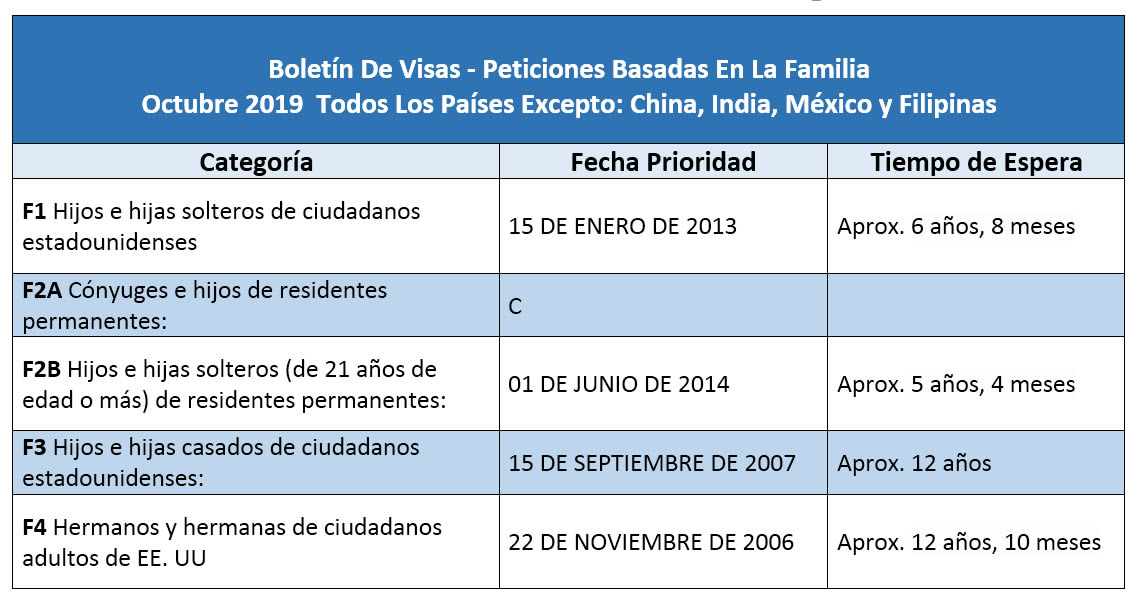
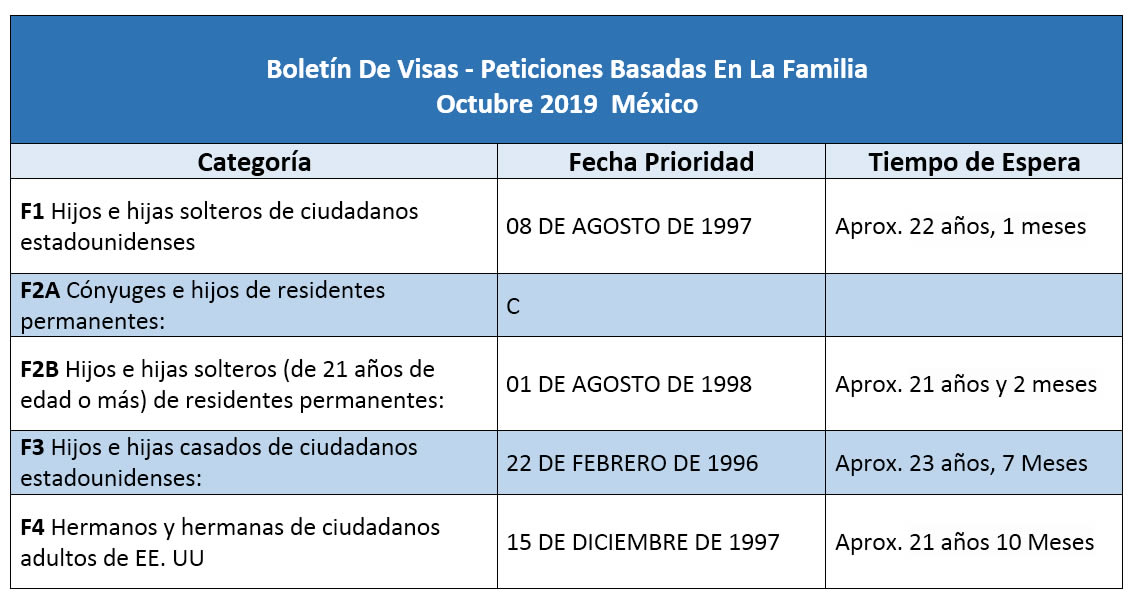
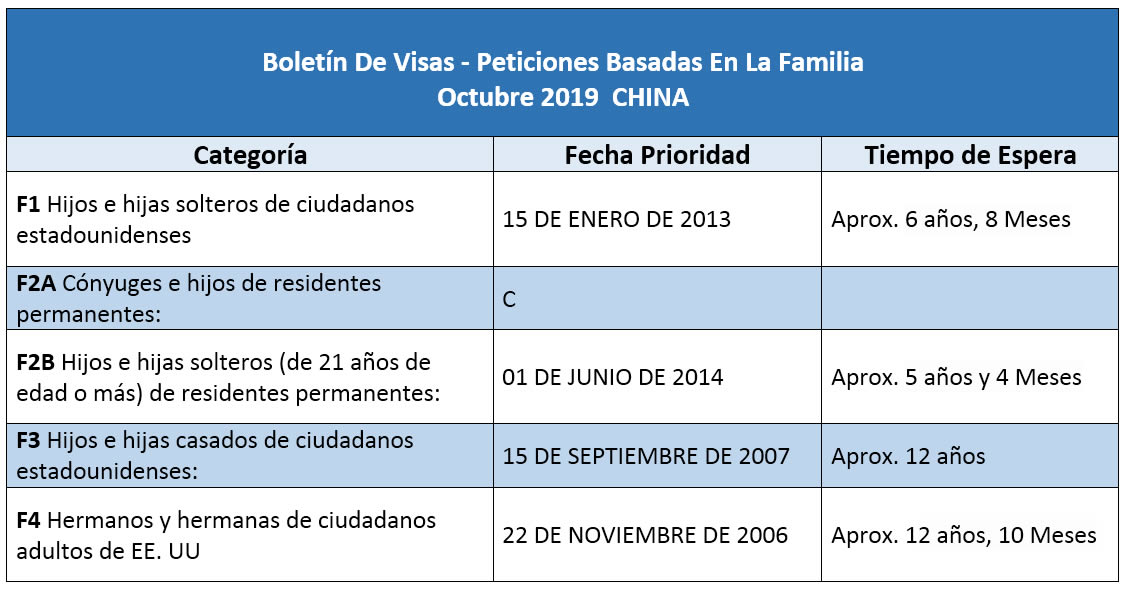
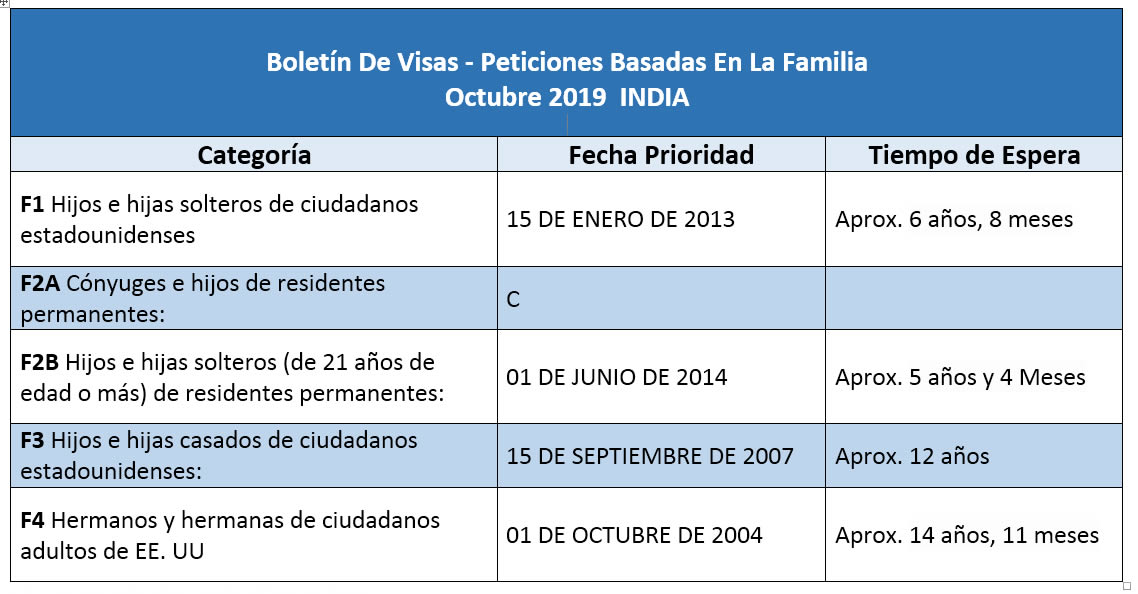
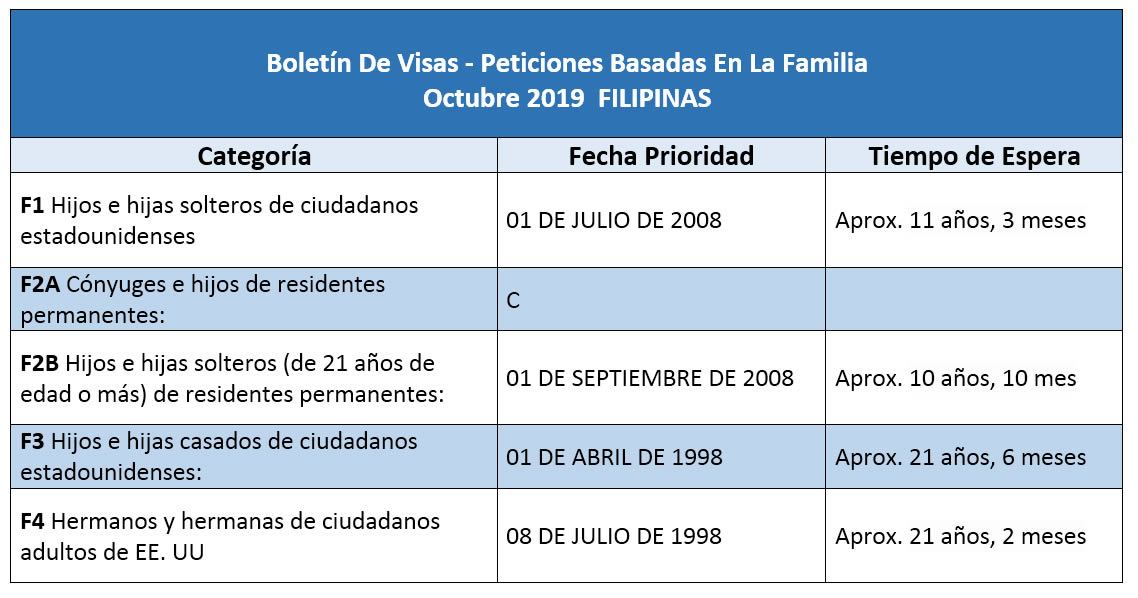
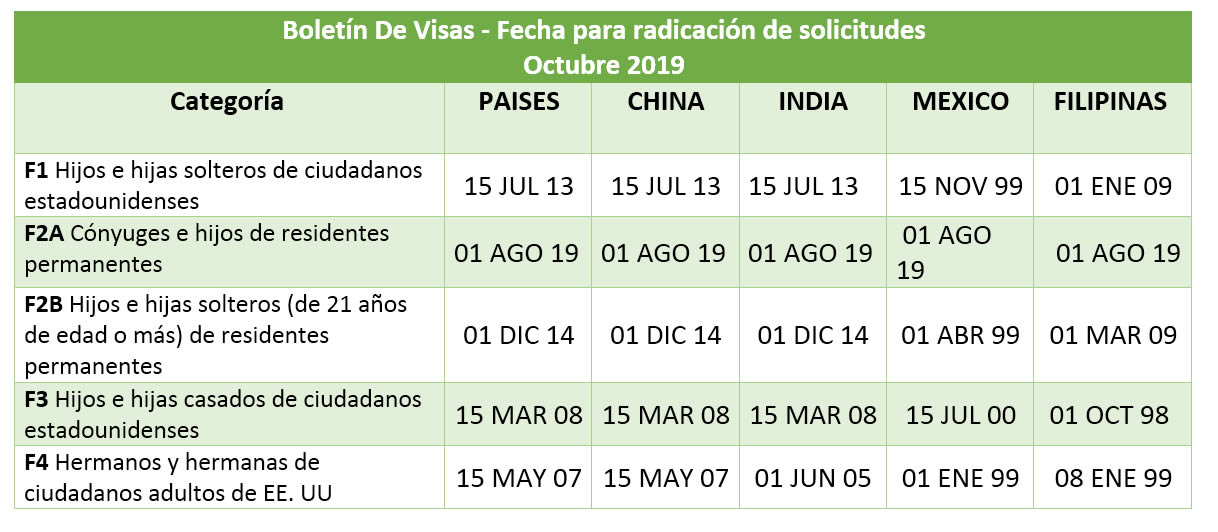
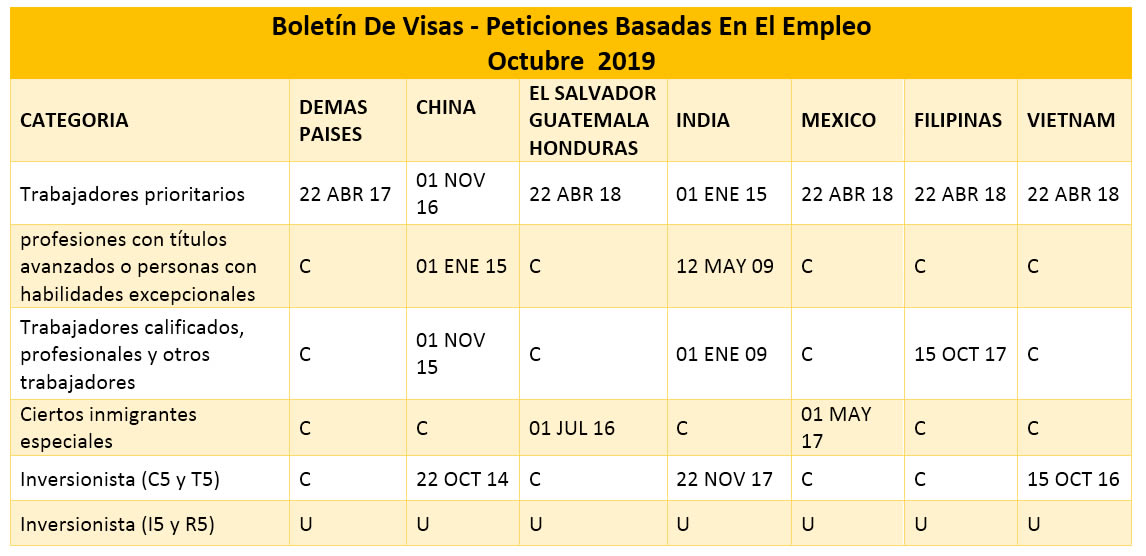







martes, 1 de octubre de 2019
Nuevo Sistema Portal Electrónico De Solicitud De Trabajador Extranjero
El 1 de octubre, el Departamento de Trabajo de Estados Unidos (DOL, por sus siglas en inglés) implementó su nuevo sistema de Portal Electrónico de Solicitud de Trabajador Extranjero (FLAG, por sus siglas en inglés) para el programa de trabajadores agrícolas temporales H-2A. A partir del 1 de octubre, los empleadores que presenten una solicitud H-2A para una certificación laboral temporal en FLAG solo recibirán la certificación electrónicamente.
Este portal recientemente modernizado ayudará a los empleadores estadounidenses a encontrar trabajadores calificados y garantizará la protección de los trabajadores estadounidenses y extranjeros.
Si su solicitud de certificación laboral temporal se procesó en FLAG, debe incluir una copia impresa de la determinación final electrónica de una página de su aprobación de certificación laboral temporal H-2A cuando presente su Formulario I-129, Petición de Trabajador No Inmigrante. Consideraremos una copia impresa de la determinación final como su certificación laboral temporal original y válida.
También debe asegurarse de que el Número de Caso de DOL identificado en la determinación final sea el mismo que el Número de Caso de ETA que proporciona en la Parte 5, Artículo 2 de su Formulario I-129.
Fuente: El Servicio de Ciudadanía e Inmigración de Estados Unidos (USCIS)
https://www.inmigracionyvisas.com/a4511-Portal-Electronico-de-Solicitud-de-Trabajador-Extranjero-html
Instructions For The 2021 Diversity Immigrant Visa Program DV-2021
Program Overview
The Department of State annually administers the statutorily-mandated Diversity Immigrant Visa Program. Section 203(c) of the Immigration and Nationality Act (INA) provides for a class of immigrants known as “diversity immigrants” from countries with historically low rates of immigration to the United States. For Fiscal Year 2021, 55,000 Diversity Visas (DVs) will be available. There is no cost to register for the DV program.
Applicants who are selected in the program (selectees) must meet simple but strict eligibility requirements to qualify for a diversity visa. The Department of State determines selectees through a randomized computer drawing. The Department of State distributes diversity visas among six geographic regions, and no single country may receive more than seven percent of the available DVs in any one year.
For DV-2021, natives of the following countries are not eligible to apply, because more than 50,000 natives of these countries immigrated to the United States in the previous five years:
Bangladesh, Brazil, Canada, China (mainland-born), Colombia, Dominican Republic, El Salvador, Guatemala, Haiti, India, Jamaica, Mexico, Nigeria, Pakistan, Philippines, South Korea, United Kingdom (except Northern Ireland) and its dependent territories, and Vietnam.
Persons born in Hong Kong SAR, Macau SAR, and Taiwan are eligible.
Eligibility
Requirement #1:
Individuals born in countries whose natives qualify may be eligible to enter. If you were not born in an eligible country, there are two other ways you might be able to qualify.
Was your spouse born in a country whose natives are eligible? If yes, you can claim your spouse’s country of birth – provided that both you and your spouse are named on the selected entry, are found eligible and issued diversity visas, and enter the United States simultaneously.
Were you born in a country whose natives are ineligible, but in which neither of your parents was born or legally resident at the time of your birth? If yes, you may claim the country of birth of one of your parents if it is a country whose natives are eligible for the DV-2021 program. For more details on what this means, see the Frequently Asked Questions.
Requirement #2:
Each DV applicant must meet the education/work experience requirement of the DV program by having either
At least a high school education or its equivalent, defined as successful completion of a 12-year course of formal elementary and secondary education;
OR
Two years of work experience within the past five years in an occupation that requires at least two years of training or experience to perform. The Department of State will use the U.S. Department of Labor’s O*Net Online database to determine qualifying work experience.
Entry period
Applicants must submit entries for the DV-2021 program electronically at dvlottery.state.gov. between noon, Eastern Daylight Time (EDT) (GMT-4), Wednesday, October 2, 2019, and noon, Eastern Standard Time (EST) (GMT-5), Tuesday, November 5, 2019. Do not wait until the last week of the registration period to enter, as heavy demand may result in website delays. No late entries or paper entries will be accepted. The law allows only one entry per person during each registration period. The Department of State uses sophisticated technology to detect multiple entries. Individuals with more than one entry will be disqualified.
Completing your Electronic Entry for the DV-2021 Program
Submit your Electronic Diversity Visa Entry Form (E-DV Entry Form or DS-5501), online at dvlottery.state.gov. We will not accept incomplete entries. There is no cost to submit an entry form. Please use an updated browser when submitting your application; older browsers (Internet Explorer 8, for example) will likely encounter problems with the online DV system We strongly encourage you to complete the entry form yourself, without a “visa consultant,” “visa agent,” or other facilitator who offers to help. If someone helps you, you should be present when your entry is prepared so you can provide the correct answers to the questions and retain the confirmation page and your unique confirmation number. It is extremely important that you retain your confirmation page and unique confirmation number.
Without this information, you will not be able to access the online system that informs you of your entry status. Be wary if someone offers to keep this information for you. You also should retain access to the email account listed in your E-DV entry. See the Frequently Asked Questions for more information about Diversity Visa program scams. You may also wish to view our video for an introduction to the Diversity Visa program and step-by-step guide to help you submit an entry
After you submit a complete entry, you will see a confirmation screen containing your name and a unique confirmation number. Print this confirmation screen for your records. Starting May 5, 2020, you will be able to check the status of your entry by returning to dvlottery.state.gov. , clicking on Entrant Status Check, and entering your unique confirmation number and personal information. You must use Entrant Status Check to check if you have been selected for DV-2021 and if selected, to check your immigrant visa interview appointment date. The U.S. government will not inform you directly. Entrant Status Check is the sole source for instructions on how to proceed with your application. Please review the Frequently Asked Questions for more information about the selection process.
You must provide all of the following information to complete your entry. Failure to accurately include all the required information will result in mandatory disqualification of your entry.
1. Name – last/family name, first name, middle name – exactly as it appears on your passport. If you have only one name, it must be entered in the last/family name field.
2. Gender – male or female.
3. Birth date – day, month, year.
4. City where you were born
5. Country where you were born – Use the name of the country currently used for the place where you were born.
6. Country of eligibility for the DV program – Your country of eligibility will normally be the same as your country of birth. Your country of eligibility is not related to where you live or your nationality, if it is different from your country of birth. If you were born in a country that is not eligible, please review the Frequently Asked Questions to see if there is another way you may be eligible.
7. NEW FOR DV-2021: The passport number, country of issuance, and expiration date for the principal entrant’s valid, unexpired international travel passport. This requirement applies to the principal entrant only, not to dependents. You must enter valid international travel passport information unless you are stateless, a national of a Communist-controlled country and unable to obtain a passport from the government of the Communist-controlled country, or the beneficiary of an individual waiver approved by the Secretary of Homeland Security and the Secretary of State.
8. Entrant photograph(s) – Recent photographs (taken within the last six months) of yourself, your spouse, and all your children. See Submitting a Digital Photograph for compositional and technical specifications. You do not need to include a photograph for a spouse or child who is already a U.S. citizen or a Lawful Permanent Resident, but you will not be penalized if you do. DV entry photographs must meet the same standards as U.S. visa photos. Your entry will be disqualified or your visa application refused if the entry photographs for you and your family members do not fully meet these specifications or have been manipulated in any way. Submitting the same photograph that was submitted with a prior year’s entry will result in disqualification. See Submitting a Digital Photograph (below) for more information.
9. Mailing Address – In Care Of Address Line 1 Address Line 2 City/Town District/Country/Province/State Postal Code/Zip Code Country
10. Country where you live today.
11. Phone number (optional).
12. Email address – An email address to which you have direct access, and will continue to have direct access, after we notify selectees in May of next year. If your entry is selected and you respond to the notification of your selection through the Entrant Status Check, you will receive follow-up email communication from the Department of State notifying you that details of your immigrant visa interview are available on Entrant Status Check. The Department of State will never send you an email telling you that you have been selected for the DV program. See the Frequently Asked Questions for more information about the selection process.
13. Highest level of education you have achieved, as of today: (1) Primary school only, (2) Some high school, no diploma, (3) High school diploma, (4) Vocational school, (5) Some university courses, (6) University degree, (7) Some graduate-level courses, (8) Master’s degree, (9) Some doctorallevel courses, and (10) Doctorate. See the Frequently Asked Questions for more information about educational requirements.
14. Current marital status: (1) Unmarried, (2) married and my spouse is NOT a U.S. citizen or U.S. Lawful Permanent Resident (LPR), (3) married and my spouse IS a U.S. citizen or U.S. LPR, (4) divorced, (5) widowed, or (6) legally separated. Enter the name, date of birth, gender, city/town of birth, and country of birth of your spouse, and a photograph of your spouse meeting the same technical specifications as your photo. Bbb Failure to list your eligible spouse or, listing someone who is not your spouse, will result in your disqualification as the Diversity Visa principal applicant and refusal of all visa applications in your case at the time of the visa interview.
You must list your spouse even if you currently are separated from him/her, unless you are legally separated. Legal separation is an arrangement when a couple remain married but live apart, following a court order. If you and your spouse are legally separated, your spouse will not be able to immigrate with you through the Diversity Visa program. You will not be penalized if you choose to enter the name of a spouse from whom you are legally separated. If you are not legally separated by a court order, you must include your spouse even if you plan to be divorced before you apply for the Diversity Visa. Failure to list your eligible spouse is grounds for disqualification.
If your spouse is a U.S. citizen or Lawful Permanent Resident, do not list him/her in your entry. A spouse who is already a U.S. citizen or LPR will not require or be issued a visa. Therefore, if you select “married and my spouse IS a U.S. citizen or U.S. LPR” on your entry, you will not be prompted to include further information on your spouse. See the Frequently Asked Questions for more information about family members.
15. Number of children – List the name, date of birth, gender, city/town of birth, and country of birth for all living unmarried children under 21 years of age, regardless of whether they are living with you or intend to accompany or follow to join you, should you immigrate to the United States. Submit individual photographs of each of your children using the same technical specifications as your own photograph.
Be sure to include:
- all living natural children;
- all living children legally adopted by you; and,
- all living step-children who are unmarried and under the age of 21 on the date of your electronic entry, even if you are no longer legally married to the child’s parent, and even if the child does not currently reside with you and/or will not immigrate with you.
Married children and children who are already aged 21 or older when you submit your entry are not eligible for the DV program. However, the Child Status Protection Act protects children from “aging out” in certain circumstances. If you submit your DV entry before your unmarried child turns 21, and the child turns 21 before visa issuance, it is possible that he or she may be treated as though he or she were under 21 for visa processing purposes.
A child who is already a U.S. citizen or LPR when you submit your DV entry will not require or be issued a Diversity Visa; you will not be penalized for either including or omitting such family members from your entry.
Failure to list all children who are eligible or, listing someone who is not your child, will result in disqualification of the principal applicant and refusal of all visa applications in the case at the time of the visa interview. See the Frequently Asked Questions for more information about family members.
Selection of Applicants
Based on the allocations of available visas in each region and country, the Department of State will randomly select individuals by computer from among qualified entries. All DV-2021 entrants must go to the Entrant Status Check using the unique confirmation number saved from their DV-2021 online entry registration to find out whether their entry has been selected in the DV program. Entrant Status Check will be available on the E-DV website at dvlottery.state.gov. beginning May 5, 2020, through September 30, 2021.
If your entry is selected, you will be directed to a confirmation page providing further instructions, including information about fees connected with immigration to the United States. Entrant Status Check will be the ONLY means by which the Department of State notifies selectees of their selection for DV2021. The Department of State will not mail notification letters or notify selectees by email. U.S. embassies and consulates will not provide a list of selectees. Individuals who have not been selected also ONLY will be notified through Entrant Status Check on the E-DV website. You are strongly encouraged to access Entrant Status Check yourself. Do not rely on someone else to check and inform you.
In order to immigrate, DV selectees must be admissible to the United States. The DS-260, Online Immigrant Visa and Alien Registration Application, electronically, and the consular officer, in person, will ask you questions about your eligibility to immigrate under U.S. law. These questions include criminal and security related topics.
All selectees, including family members, must be issued visas by September 30, 2021. Under no circumstances can the Department of State issue DVs nor can USCIS approve adjustments after this date, nor can family members obtain DVs to follow-to-join the principal applicant in the United States after this date.
Submitting a Digital Photograph (Image)
You can take a new digital photograph or scan a recent (taken within the last six months) photograph with a digital scanner, as long as it meets all of the standards below. DV entry photos must be of the same quality and composition as U.S. visa photos. You can see examples of acceptable photos here . Do not submit a photograph older than six months or a photograph that does not meet all of the standards described below. Submitting the same photograph that you submitted with a prior year’s entry, a photograph that has been manipulated, or a photograph that does not meet the specifications below will result in disqualification.
Your photos or digital images must be
- In color
- In focus
- Sized such that the head is between 1 inch and 1 3/8 inches (22 mm and 35 mm) or 50 percent and 69 percent of the image's total height from the bottom of the chin to the top of the head. View the Photo Composition Template for more size requirement details.
- Taken within the last six months to reflect your current appearance
- Taken in front of a plain white or off-white background
- Taken in full-face view directly facing the camera
- With a neutral facial expression and both eyes open
- Taken in clothing that you normally wear on a daily basis
- Uniforms should not be worn in your photo, except religious clothing that is worn daily.
- Do not wear a hat or head covering that obscures the hair or hairline, unless worn daily for a religious purpose. Your full face must be visible, and the head covering must not cast any shadows on your face
- Headphones, wireless hands-free devices, or similar items are not acceptable in your photo.
- Do not wear eyeglasses
- If you normally wear a hearing device or similar articles, they may be worn in your photo.
Review the Photo Examples to see examples of acceptable and unacceptable photos. Photos copied or digitally scanned from driver’s licenses or other official documents are not acceptable. In addition, snapshots, magazine photos, low quality vending machine or mobile phone photos, and full-length photographs are not aceptable
You must upload your digital image as part of your entry. Your digital image must be:
- In JPEG (.jpg) file format
- Equal to or less than 240 kB (kilobytes) in file size
- In a square aspect ratio (height must equal width)
- 600x600 pixels in dimensión
Do you want to scan an existing photo? In addition to the digital image requirements, your existing photo must be:
- 2 x 2 inches (51 x 51 mm)
- Scanned at a resolution of 300 pixels per inch (12 pixels per millimeter)
Use the Department of State’s free photo tool to:
- select a digital image stored on your computer
- Resize and rotate it if necessary
- Crop it to a square image of exactly 600 x 600 pixels
Taking photos of your baby or toddler
When taking a photo of your baby or toddler, no other person should be in the photo, and your child should be looking at the camera with his or her eyes open
Tip 1:
Lay your baby on his or her back on a plain white or off-white sheet. This will ensure your baby's head is supported and provide a plain background for the photo. Make certain there are no shadows on your baby's face, especially if you take a picture from above with the baby lying down
Tip 2:
Cover a car seat with a plain white or off-white sheet and take a picture of your child in the car seat. This will also ensure your baby’s head is supported
Source: https://travel.state.gov
https://www.inmigracionyvisas.com/a4510-Instructions-For-The-2021-Diversity-Immigrant-Visa.html
Servicios De Naturalización Para Militares Se Prestaran En Cuatro Bases Militares
El Servicio de Ciudadanía e Inmigración de Estados Unidos (USCIS, por sus siglas en inglés) anunció que proporcionará servicios de naturalización para militares en cuatro bases militares ubicadas en el extranjero debido a un ajuste en su presencia internacional y el cierre de oficinas en el extranjero.
Los militares y familiares elegibles destacados en el extranjero completarán ahora su proceso de naturalización en uno de los cuatro “centros de operaciones” ubicados en:
- Camp Humphreys, en Corea del Sur;
- Commander Fleet Activities Yokosuka, en Japón;
- U.S. Army Garrison Stuttgart, en Alemania;
- Naval Support Activity Naples, en Italia.
Dichos centros fueron seleccionados a base de su proximidad a localidades de Oficinas Internacionales de USCIS donde históricamente se proveyeron la mayoría de los servicios de naturalización para militares en el extranjero.
“Asegurarnos de que los hombres y mujeres que dedican sus vidas a proteger a Estados Unidos puedan convertirse en ciudadanos estadounidenses mientras sirven en el extranjero es de importancia fundamental”, dijo el director en funciones de USCIS, Ken Cuccinelli. “Los militares y sus familiares sacrifican mucho para mantener la seguridad y libertad de nuestro país. Agradezco al Departamento de la Defensa su colaboración con USCIS para asegurarnos de que dichos servicios continúen disponibles durante el tiempo que estén destacados en el extranjero.”
Los oficiales de USCIS, en colaboración estrecha con el Departamento de la Defensa, viajarán cada trimestre durante una semana para proporcionar servicios de naturalización en estas localidades, y responder las preguntas de los solicitantes. Se requerirá cita previa a fin de que los oficiales de USCIS puedan tener la información necesaria acerca de los casos para poder completar su procesamiento. En el año fiscal (FY) 2018, USCIS recibió 347 solicitudes de naturalización de militares en el extranjero. Hasta este momento del FY 2019, la agencia ha recibido 520.
Las primeras visitas de oficiales de USCIS a estos centros de operaciones están programadas para finales de octubre y principios de noviembre a Camp Humphreys, en Corea del Sur, y Commander Fleet Activities Yokosuka, en Japón, respectivamente. La Oficina Local de USCIS en Seúl cerrará el 30 de septiembre, por lo que esta región será la primera en recibir servicios en estos centros de operaciones. Otras regiones extranjeras se incorporarán gradualmente a este enfoque de centros de operaciones durante los próximos nueve meses. Si un solicitante no puede viajar al centro designado durante el trimestre en que los oficiales de USCIS estén en el lugar, USCIS seguirá los procedimientos en vigor y coordinará con el solicitante de manera individual para determinar la mejor manera para manejar su caso.
USCIS llevará a cabo una teleconferencia el 9 de octubre para hablar de las ubicaciones actualizadas y también coordinará eventos de participación durante las visitas a los centros de operaciones para informar a los militares acerca de los procedimientos para la ciudadanía y la naturalización, así como proporcionar información general acerca de las peticiones y solicitudes de USCIS.
En agosto de 2019, en un esfuerzo por agilizar y hacer el proceso de inmigración más eficiente, USCIS anunció que cerraría gradualmente oficinas internacionales con la excepción de siete, antes de julio de 2020. Muchos servicios actualmente proporcionados en las oficinas internacionales serán proporcionados en Estados Unidos por oficiales destacados temporalmente a una Oficina Local de USCIS en el extranjero, o por el Departamento de Estado (DOS, por sus siglas en inglés).
USCIS tiene disponible una línea telefónica libre de costo para ayuda a militares, 877-CIS-4MIL (877-247-4645, TTY 800-877-8339) y el correo electrónico militaryinfo@uscis.dhs.gov exclusivamente para militares y sus familiares, así como para veteranos. Representantes están disponibles para contestar preguntas de lunes a viernes de 8:00 a.m. a 4:00 p.m. tiempo central, excluidos los días observados por el gobierno federal. Los miembros de las Fuerzas Armadas y sus familiares elegibles destacados en Estados Unidos o en el extranjero, también pueden acceder a la línea de ayuda mediante el número gratuito a través de la operadora de su base militar o del Sistema de Redes de Intercambio la Defensa (DSN, por sus siglas en inglés). Información adicional está disponible en la página web.
Fuente: El Servicio de Ciudadanía e Inmigración de Estados Unidos
https://www.inmigracionyvisas.com/a4509-servicios-de-naturalizacion-para-militares.html
Suscribirse a:
Entradas (Atom)









